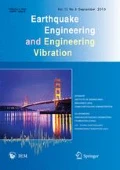Abstract
The electromagnetic mass damper (EMD) control system, as an innovative active control system to reduce structural vibration, offers many advantages over traditional active mass driver/damper (AMD) control systems. In this paper, studies of several EMD control strategies and bench-scale shaking table tests of a two-story model structure are described. First, two structural models corresponding to uncontrolled and Zeroed cases are developed, and parameters of these models are validated through sinusoidal sweep tests to provide a basis for establishing an accurate mathematical model for further studies. Then, a simplified control strategy for the EMD system based on the pole assignment control algorithm is proposed. Moreover, ideal pole locations are derived and validated through a series of shaking table tests. Finally, three benchmark earthquake ground motions and sinusoidal sweep waves are imposed onto the structure to investigate the effectiveness and feasibility of using this type of innovative active control system for structural vibration control. In addition, the robustness of the EMD system is examined. The test results show that the EMD system is an effective and robust system for the control of structural vibrations.
Similar content being viewed by others
References
Abdel-Rohman M and Leipholz HHE (1978), “Structural Control by Pole Assignment Method,” ASCE Journal of Engineering Mechanics, 104: 1157–1175.
Battaini M, Yang G and Spencer BF Jr (2000), “Bench-Scale Experiment for Structural Control,” ASCE Journal of Engineering Mechanics, 126(2): 140–148.
Chu SY, Soong TT, and Reinhorn AM (2002), “Real-time Active Control Verification via a Structural Simulator,” Engineering Structures, 24(3): 343–353.
Dyke SJ, Spencer BF, Belknap AE, Ferrell KJ, Quast P, and Sain MK (1994), “Absolute Acceleration Feedback Control Strategies for the Active Mass Driver,” Proc. First World Conference on Structural Control, Pasadena, California, Vol. 2 (TP1), pp.51–60.
Dyke SJ, Spencer BF Jr, Quast P, Kaspari DC Jr. and Sain MK (1996), “Implementation of an Active Mass Driver Using Acceleration Feedback Control,” Microcomputers in Civil Engineering: Special Issue on Active and Hybrid Structural Control, 11: 305–323.
Guo AX, Xu YL and Li H (2007), “Dynamic Performance of Cable-stayed Bridge Tower with Multistage Pendulum Mass Damper under Wind Excitations I: Theory,” Earthquake Engineering and Engineering Vibration, 6(3): 295–306.
Housner GW, Bergman LA, Caughey TK, Chassiakos AG, Claus RO, Masri SF, Skelton RE, Soong TT, Spencer BF and Yao JTP (1997), “Structural Control: Past, Present, and Future,” J. Engng Mech, ASCE, 123(9): 897–971.
Ou JP (2003), Structural Vibration Control — Active, Semi-active and Smart Control, Science Press, Beijing. (in Chinese)
Ou JP and Zhang CW (2007), “Modeling and Dynamical Testing of an Innovative Electro-magnetic Active Mass Driver Control System for Structural Vibration,” Chinese High Technology Letters, 17(4): 382–388. (in Chinese)
Quanser Consulting Inc. (2002), Active Mass Damper: Two-Floor (AMD-2), User Manual.
Quast P, Sain MK, Spencer BF Jr and Dyke SJ (1995), “Microcomputer Implementations of Digital Control Strategies for Structural Response Reduction,” Microcomputers in Civil Engineering: Special Issue on New Directions in Computer Aided Structural System Analysis, Design and Optimization, 10: 13–25.
Samali B, Al-Dawod M and Li JC (2003), “Performance of an Active Mass Driver System on a Five Storey Benchmark Model,” JSME International Journal, Series C: Mechanical Systems, Machine Elements and Manufacturing, 46(3): 848–853.
Shiba K, Nakamura Y and Yokota H (1989), “Experimental Study on Structural Control for Seismic Loads Using Passive and Active Devices,” Seismic Engineering: Research and Practice, San Francisco, CA, USA, May 1–5: 129–138.
Song G, Lin JH, Zhao Y, Howson WP and Williams FW (2007), “Robust H Infinite Control for Aseismic Structures with Uncertainties in Model Parameters,” Earthquake Engineering and Engineering Vibration, 6(4): 409–416.
Soong TT (1990), Active Structure Control Theory and Practice, Longman Scientific & Technical. New York, USA.
Spencer BF Jr, Dyke SJ and Deoskar HS (1998), “Benchmark Problems in Structural Control: Part I — Active Mass Driver System,” Earthquake Engineering and Structural Dynamics, 27(11): 1127–1139.
Spencer BF Jr and Nagarajaiah S (2003), “State of the Art of Structural Control,” ASCE Journal of Structural Engineering, 129(7): 845–856.
Spencer BF Jr and Sain MK (1997), “Controlling Buildings: A New Frontier in Feedback,” IEEE Control Systems Magazine: Special Issue on Emerging Technologies (Tariq Samad Guest Ed.), 17(6): 19–35.
Tong M and Liebner T (2007), “Loss of Energy Dissipation Capacity from the Deadzone in Linear and Nonlinear Viscous Damping Devices,” Earthquake Engineering and Engineering Vibration, 6(1): 11–20.
Wang SG, Yeh HY and Roschke PN (2001), “Robust Control for Structural Systems with Parametric and Unstructured Uncertainties,” Proceedings of the American Control Conference. Arlington, VA, pp.1109–1114.
Xu L, Yi WJ and Yi ZH (2007), “Uncertainty Analysis of Strain Modal Parameters by Bayesian Method Using Frequency Response Function,” Earthquake Engineering and Engineering Vibration, 6(2): 183–189.
Xue DY (2000), Design and Analysis of Feedback Control System: the Application of MATLAB, Tsinghua University Press, Beijing. (in Chinese)
Yao JTP (1972), “Concept of Structure Control,” Journal of Structure Division, ASCE, 98(ST7): 1567–1574.
Yoshida I, Kurose H, Fukui S and Iemura H (1995), “Parameter Identification on Active Control of a Structural Model,” Smart Materials and Structures, 4(1A): A82–A90.
Zhang CW (2005), “Electromagnetic AMD Systems and their Relevant Theory and Experiments for Structural Vibration Control,” Ph.D thesis, of Harbin Institute of Technology, Harbin.
Zhang CW and Ou JP (2008), “Control Structure Interaction of Electromagnetic Mass Damper System for Structural Vibration Control,” Journal of Engineering Mechanics ASCE, 134(5), 1–9.
Author information
Authors and Affiliations
Corresponding author
Additional information
Supported by: The National Natural Science Foundation of China Under Grant. No.50608026 and The National Major Foundamental Program (973 Program) of China Under Grant No. 2007CB714204
Rights and permissions
About this article
Cite this article
Zhang, C., Ou, J. Control strategies and experimental verifications of the electromagnetic mass damper system for structural vibration control. Earthq. Eng. Eng. Vib. 7, 181–192 (2008). https://doi.org/10.1007/s11803-008-0828-5
Received:
Accepted:
Published:
Issue Date:
DOI: https://doi.org/10.1007/s11803-008-0828-5




